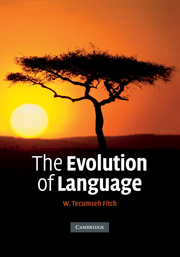Book contents
- Frontmatter
- Contents
- List of figures
- Acknowledgments
- Introduction
- SECTION 1 THE LAY OF THE LAND
- SECTION 2 MEET THE ANCESTORS
- SECTION 3 THE EVOLUTION OF SPEECH
- 8 The evolution of the human vocal tract
- 9 The evolution of vocal control: the neural basis for spoken language
- 10 Models of the evolution of speech and phonology
- SECTION 4 EVALUATING PHYLOGENETIC MODELS OF LANGUAGE EVOLUTION
- Glossary
- Appendix: species names
- References
- Author index
- Subject index
- Species index
8 - The evolution of the human vocal tract
Published online by Cambridge University Press: 05 June 2012
- Frontmatter
- Contents
- List of figures
- Acknowledgments
- Introduction
- SECTION 1 THE LAY OF THE LAND
- SECTION 2 MEET THE ANCESTORS
- SECTION 3 THE EVOLUTION OF SPEECH
- 8 The evolution of the human vocal tract
- 9 The evolution of vocal control: the neural basis for spoken language
- 10 Models of the evolution of speech and phonology
- SECTION 4 EVALUATING PHYLOGENETIC MODELS OF LANGUAGE EVOLUTION
- Glossary
- Appendix: species names
- References
- Author index
- Subject index
- Species index
Summary
Speech is not language, but is important nonetheless
Speech (complex, articulated vocalization) is the default linguistic signaling mode for all human cultures, except when the audio-vocal modality is unavailable, as for the deaf. Though speech is the default linguistic modality, it is not the only possibility. Signed languages of the deaf are full, complex, grammatical languages, independent of but equivalent to spoken languages (Stokoe, 1960; Klima and Bellugi, 1979), and this demonstrates that speech is not the only signaling system adequate to convey language. Writing is another example of a visuo-manual system of linguistic communication, but since writing systems are typically “parasitic” representations of spoken systems, they illustrate the multi-modality of language less convincingly. One of the first distinctions to be made in studying language evolution is therefore that between speech (a signaling system) and language (a system for expressing thoughts, which can incorporate any one of several signaling systems). Many languages use the same word to designate both speech and language (e.g. German Sprache), and in English one often finds the word speech used as an exact synonym for language, showing how close these concepts are in everyday use. Throughout this book, I will use “speech” only in the narrow sense of complex articulated vocalizations, where “articulated” implies tight coordination between the supralaryngeal vocal tract and the larynx. Besides linguistic speech, other examples of articulated vocalization include infant babbling, “speaking in tongues,” nonsense speech, jazz scat singing, or Asian formant singing.
- Type
- Chapter
- Information
- The Evolution of Language , pp. 297 - 337Publisher: Cambridge University PressPrint publication year: 2010
- 1
- Cited by



